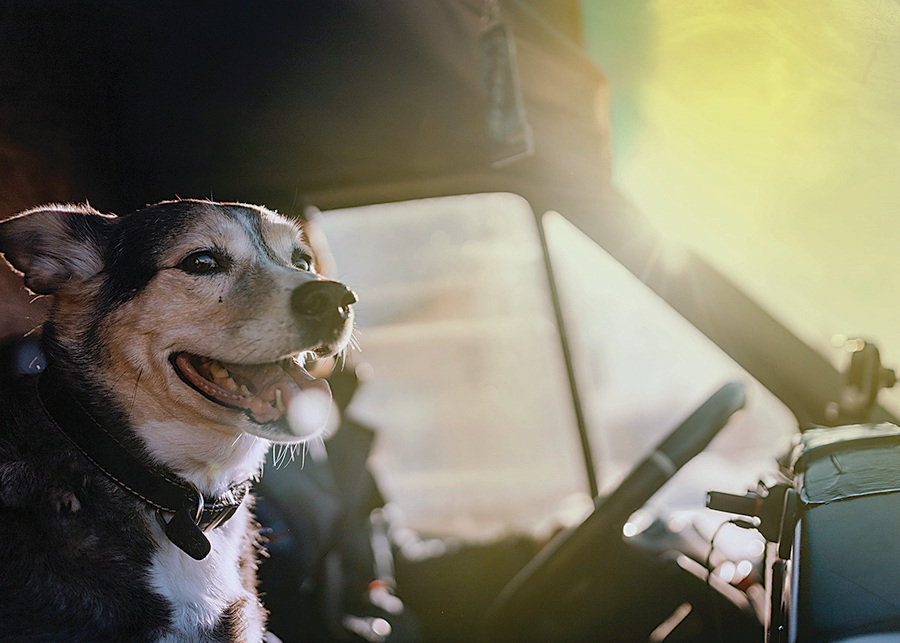By Shari King
The following is a true story. Joann (not her real name) was a veterinarian who was fortunate to own her own animal hospital. As the owner, she often brought her two large dogs, Cooper and Ducky, to the clinic with her.
One hot day in July, her husband dropped Cooper, the younger of the two dogs, off at a veterinary surgeon in the early morning for a scheduled ACL repair (knee surgery). Joann was worried about the dog, but personally knew the surgeon and was certain he was in good hands.

She left for work in her black Suburban with Ducky, the older dog. Usually her commute to the clinic was boisterous with Cooper moving from window to window, but Ducky was a mellow golden retriever. He lay down quietly in the rear seat of the vehicle and fell asleep.
Just as she arrived at the clinic, her husband called on her cell to ask if he was to pick up Cooper. Joann, distracted by her phone conversation about her younger dog’s surgery and with her busy schedule for the day forgot that Ducky was in the car.
When the surgeon called her with an update on Cooper’s surgery hours later she suddenly remembered that she had brought Ducky to work with her, but by then it was too late.
Every year, many dogs suffer and die when owners make the mistake of leaving them in a parked car. It can happen even to a veterinarian.
Parked cars are deathtraps for dogs. According to the American Veterinary Medical Association (AVMA) the temperature inside a vehicle can rise almost 20 degrees in as little as 10 minutes. A vehicle can quickly reach a temperature that puts a pet at serious risk for heatstroke and death, even on days when it doesn’t seem all that hot to you.
An independent study that was published on the AVMA website showed that the interior temperature of vehicles parked outside ranged from 72 to 96 degrees Fahrenheit, and those temperatures rose steadily as time increased. The study also found that cracking the windows had very little effect on the temperature inside a vehicle.
Another study, performed by the Louisiana Office of Public Health, found that the temperatures in dark sedans as well as a light gray minivans parked on a hot, but partly cloudy day, exceeded 125 degrees within 20 minutes.
Animals can sustain brain damage or even die from heatstroke in as little as 15 minutes. Beating the heat is extra tough for dogs because they can only cool themselves by panting and by sweating through the pads on their feet.
Unlike us humans, dogs and cats don’t respond to heat in the same way. We regulate our body temperature through the many sweat glands all over our bodies. Dogs and cats have only a few sweat glands located in their paw pads and around their noses.
In order to cool themselves, our pets release heat primarily by panting. The sweat glands in their paw pads and noses do help with dispersing heat but only minimally.
Hyperthermia, or heatstroke, occurs when your pet’s body temperature reaches 106 degrees or higher.
At this temperature, neurological and organ dysfunction and failure occurs. Once their temperature reaches 108 degrees or higher, it melts the proteins which make up the foundation of all the cells in the body.
While there is no definite point at which these systems fail, higher temperatures and longer periods of heat exposure will lead to more organ dysfunctions and the distinct possibility of death.
Heatstroke symptoms may include restlessness, excessive thirst, thick saliva, heavy panting, lethargy, lack of appetite, dark tongue, rapid heartbeat, fever, vomiting, bloody diarrhea, and lack of coordination. If a dog ever shows any of these symptoms, get him or her out of the heat, into an air-conditioned vehicle, and then transport that pet to a veterinarian immediately.
If you are unable to transport the animal, bring the dog into an air-conditioned building and call animal control and tell them it is an emergency. Provide water to drink, and if possible, spray the dog with a garden hose or immerse him or her in a tub of cool—not cold—water to lower the body temperature. Avoid covering the animal’s body with wet towels or blankets as the heat needs to be able to disperse.
You can also place the dog in front of an electric fan and apply cool, wet towels to the groin, stomach, chest, and paws. Be careful not to use ice or ice cold water: the temperature should be decreased gradually to allow the dog’s body to acclimate.
If a pet needs to be hospitalized from heatstroke, the treatments to save his or her life can be costly and may include: Intravenous fluids to treat the dehydration and to cool the body down internally. Oxygen therapy, anesthesia, and airway intubation for pets that are having breathing difficulties or are unconscious. Blood tests to assess the severity of dehydration, to test for clotting problems, and to assess organ function.
Medications can include gastric protectants and anti-nausea medication in cases of vomiting and diarrhea (as the gut may slough its lining and start to die) Antibiotics to prevent secondary sepsis (blood poisoning) and pain relief medications.
The pet may need blood or plasma transfusions. And lastly, ongoing monitoring and treatment usually in an intensive care unit.
While all pets can be at risk of heatstroke, there are some pets that are more susceptible. These pets include the very young or old; thick- or long-coated dogs as their coat retains the heat; overweight and obese dogs; large breed dogs; extremely active, or working and hunting dogs, such as shepherds and retrievers.
Also included are dogs who have any type of respiratory disease or breathing problems, such as laryngeal (vocal cord) paralysis, or a collapsing trachea. Dogs who have heart problems or any type of cardiovascular disease can suffer very quickly and die from heatstroke.
According to information supplied by the Animal Emergency Service, Brachycephalic breeds are 146% more likely to suffer from heatstroke than any other dog breed.
Brachycephalic breeds are the short-nosed and flat-faced animals. Their smaller and narrower nostrils, long soft palate, and under-developed and smaller airways prevent the efficiency of adequate air flow, which means they struggle to cool themselves. These breeds include pugs, English bulldogs, French bulldogs, Pekingese, and Persian and Himalayan cats.
If you see a dog left alone in a hot car, note the car’s color, model, make, and license plate number. Have the owner paged in the nearby businesses. Call your local police to be dispatched, and animal control. Have someone keep an eye on the dog. Don’t leave the scene until the situation has been resolved.
If the authorities are unresponsive or too slow, and the dog’s life appears to be in imminent danger, find a witness and then do whatever it takes to remove the endangered animal from the car. Tend to that animal, then wait for authorities to arrive.
In fact, there is an Arizona State statute, House Bill 2494, that states you must: Notify Law Enforcement or Emergency Personnel first. Must in good faith believe the child or pet’s life is in danger. You must remain with the child or animal until emergency personnel arrive.

Animal Control Officer Shannon Gray shared that although this law protects the person breaking a window to save a pet from criminal charges, there could still be civil charges brought on by the vehicle owner for the damage. However, Arizona State Statute 13-2910, Section 7, in regards to cruelty to animals, refers to an animal confined in a motor vehicle.
It states that a person commits cruelty to animals if the person intentionally, knowingly, or recklessly leaves an animal unattended and confined in a motor vehicle and physical injury to or death of the animal is likely to result.
Every year, hundreds of dogs die from heatstroke because they are left in parked vehicles. We’ve all heard it before: “I’ll just be a few minutes while I run into the store,” or “He’ll be okay, I cracked the windows….”
These excuses don’t amount to much if your dog dies from being left in a hot vehicle.

Before you invite your dog to go and run errands with you, ask yourself, “Do I really need to take him with me?” If the answer is no, leave the dog home.
That old saying “love’em and leave ‘em” can actually be a very good thing for a dog in this situation. When it is hot, please leave your dog at home. He’ll be safe and happily waiting for you at the door when you return.
Here is a lifesaving tip that can save not only dog’s life but also sleeping babies. Take an ordinary clothes pin. Paint it. Decorate it. Or simply just write your pets on it with a Sharpie marker. Attach it to an obvious vent on the dashboard of your car.
Whenever you get into the car with your dog, attach the clothespin to your keys. It will serve as a visual reminder that you have your dog with you and can be a lifesaver.

